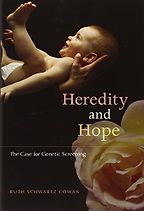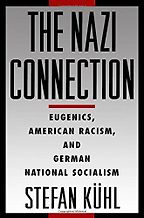Eugenics is a word that fills many people with an instinctive horror. But before we get into a discussions of ethics, perhaps you might explain what it means at its broadest definition.
It is an odd term. It was actually the work of a British scientist by the name of Francis Galton, who coined the term in 1883. It is from the Greek—eu, meaning ‘well’ or ‘good’, and the suffix –genēs, as in genes, genetics— so it basically means ‘well born’; and the way it developed in the late 19th and early 20th centuries is that it came to be thought of as the science of good breeding. The idea being: if you can breed dogs, pigeons, cattle, sheep or whatever, why can’t you do the same thing with humans? Why can’t you create a better human race, a human race that doesn’t have diseases or disabilities?
Since then it has been practised very differently, in different places, but that’s essentially what the term meant when it started out.
When we talk about selective human breeding in this context, are we talking about sterilisation?
Not always. Sterilisation is the bit of eugenics that always gets the most attention — for fairly obvious reasons. If you’re going to coerce people into being sterilised, then you’re doing something pretty fundamental within the human condition, and because of course sterilisation makes incredibly good press. It’s always been the bit of eugenics that people talk about. But actually, first of all, eugenics is much much much broader than sterilisation. That is just one slice of eugenics, and there are lots of places around the world where, when eugenics was practised and was still called eugenics, there were things happening that had nothing to do with sterilisation.
“Eugenics: from the Greek eu, meaning ‘well’ or ‘good’, and the suffix -genēs, as in genes, genetics”
If you are talking about the contemporary context, then we’re not talking about sterilisation particularly, although it can still be there. We’re talking much more about the kinds of genetic engineering that have become increasingly possible, particularly in the last 20-ish years. Essentially, the contemporary vision of that is the ‘designer baby’: ‘I’d like a kid with blond hair and blue eyes,’ or ‘I want a girl,’ or ‘I want a high IQ.’ It’s sperm banks, and IVF, it’s PGD…
Pre-natal testing?
Yes. Pre-implementation genetic diagnosis. So: do you want to get rid of a baby with Down’s Syndrome? Do you want to have certain qualities or characteristics in your baby? Those kinds of things.
We know that’s happening. We know that people are choosing to have boys or girls, or choosing not to. We know that, for a long time, people who have been able to get early diagnosis of conditions like Down’s Syndrome have been able, in some countries, to get abortions.
I think it’s changed over time, what that interference with the process of human breeding is. But even in the earlier periods, sterilisation was only one slice, one piece, one element of eugenics, and it’s a much, much, much bigger science than that.
“People have been able to get early diagnosis of conditions like Down’s Syndrome and, in some countries, to get abortions based on the results”
We tend to divide eugenics [along geographical lines]: we see a kind of Anglo-American-Teutonic version, which often stresses sterilisation; then there’s what is often called ‘Latin’ eugenics, which you get in all of the Latin American countries: Argentina, Brazil, Mexico, and so on. And you see it in places like France, Italy and to some extent Spain. There sterilisation is absolutely not part of the package, not in the slightest.
It is generally what we call ‘positive’ eugenics, which — rather than stopping people from having children — is encouraging the fit to have children and giving them incentives — whether that be cash, medals, or whatever—to have children. We also call that ‘pronatalist’ eugenics. So it can be very very different, and that’s certainly why people get confused.
The first book you’ve chosen, In the Name of Eugenics by Daniel Kevles (1985), gives a broad overview of the history of the uses of eugenics.
Dan Kevles’s book was one of the first of a new generation of writers. It is quite an old book now, and is still great, which is pretty fantastic. It was the first of these new studies on eugenics. It is quite regionalist—America and Britain, largely, a little bit of Europe—so it does not cover everything, and that’s where the other books come in.
What’s interesting and important about Kevles’s book is that it takes eugenics seriously as a science. The reason that’s important, I think, is because there’s this tendency for most people these days to be very hostile to the idea of eugenics. As you said, it fills people with horror. But at the time, it was really considered to be quite important as a science, and was taken very seriously by lots of people.
Keveles’s book asks: what did science look like in this period? How can we understand this as part of the mainstream of science at the time—even though now we think of it as a junk science?
Do you think that it maintains validity as a science?
That’s a difficult question. I would say that I don’t think eugenics has disappeared. We call it different things because we are frightened of the term, quite rightly. I don’t know that it should have a place in science, but I think it does still have a place in science.
The spectre that hangs over any conversation about eugenics is the Nazi question. This is a subject tackled by Stefan Kühl in The Nazi Connection (1994). I wonder if that’s a sensible place for us to go next.
This is a very important book, because it’s not just about what the Nazis were doing.
I think it’s important just to say here that, again, this is where eugenics gets misread. There’s no question that the Nazis were practising eugenics, but that’s not what happens specifically during the Holocaust. Most of the eugenics stuff was actually happening in the 1930s. What happened in the camps—horrific experiments and the rest of it— was not eugenics. To say that that was eugenics, as a lot of anti-eugenicists say today, is a misunderstanding of what eugenics is and what the Holocaust was.
“The Nazis got a lot of their ideas from the United States”
In the 1930s the Germans passed a series of laws, starting almost immediately when Hitler took power in 1933, that made it possible to sterilise people who were, they thought, unfit in one way or another; prevent marriages between Jews and Aryans; all of those kinds of things. Those were obviously intended to affect the outcome of reproduction or to stop reproduction. Those are the eugenic bits of Nazism.
What’s really important about Kühl’s book is that it shows that the Nazis didn’t invent this. In fact, the Nazis got a lot of their ideas—I teach this to my students, and it’s an amazing teaching moment—from the United States.
Right.
Sterilisation, the bit that you brought up earlier, the thing that everybody if they know anything about eugenics knows, began in the United States. The first legislation permitting co-erced sterilisation in the United States was in 1907. It was a state law in Indiana, the first state to allow forced sterilisation.
For the next 20 years, different states in the Union were fiddling with this, playing with it. Sometimes they would find themselves accosted with legal challenges and other forms of protest. Finally, in the late 1920s, Virginia, which was one of the most active of these sterilising states, decided that they were going to take a case to the Supreme Court because they were tired of not being sure if they could do this legally.
“He used a now very, very famous phrase: ‘Three generations of imbeciles are enough’”
So they finagled a case. It was completely fixed, no question about it. Buck vs. Bell went to the Supreme Court in 1927, and the Supreme Court ruled—Oliver Wendell Holmes, Jr. was the major writer of the decision—that it was okay to sterilise people. He used a now very, very famous phrase: ‘Three generations of imbeciles are enough.’
What that case did is that it said: you can go ahead and do this. So by the early 1930s, 33 or 34 states in the Union had sterilisation rules on the books. Most of them didn’t disappear until the late 1970s.
Didn’t Hitler hold up the US Immigration Restriction Act as an example of prime legislation in this area?
Absolutely. The Immigration Law of 1924, and the sterilisation laws that began in 1907 were well in place by the time he came to power. In fact Harry Laughlin, one of the promoters of sterilisation and eugenics in the United States, got an an honorary degree from the University of Heidelberg, a very famous German university, sometime in the 1930s, and there was a lot of swapping of ideas between the Germans and the Americans in the 20s and 30s.
There were lots of eugenicists in Germany in the 1920s, but you didn’t see this kind of full-scale, head-on stuff until the 1930s. But you did in the States. More than 60,000 people were sterilised in the States under those laws.
Presumably this is something that must have been very embarrassing for the American scientists who were involved after the war.
Well, the defence lawyers for the Germans at the Nazi Doctors’ Trial, in the late 1940s, tried to argue that Americans were doing a lot of this. So there were big attempts to say, ‘No, no, no, what we were doing was different,’ just like the Scandinavians were saying their sterilisation programmes were also different. Everybody wanted to distance themselves from what the Nazis were doing.
And that’s when the term ‘eugenics’ disappears from the literature. We actually have conversations, written notes and memos, from the late 1940s and the 1950s in which eugenicists say, ‘We have to find a way to make this palatable after the Nazis.’
Were they different? Was their defence valid?
Well, yes and no. Obviously, if you are in Latin America and you are doing what we call positive eugenics, that’s very different, although Hitler was doing that too. The Germans gave Aryan women who had more than a certain number of babies medals. There are aspects where it is similar and aspects where it isn’t.
But if you’re a pro-natalist eugenicist who doesn’t distinguish on the basis of race, that’s a very different kind of eugenics, obviously. There is a difference, but you know, it is a slippery slope on some levels. If you do one, it doesn’t really take that much to go on to the next one. It’s a very slippery slope.
Perhaps this leads into the book by Stern, Eugenic Nation (2005): ‘the faults and frontiers of better breeding in modern America.’ This is perhaps the extension of what those Americans were working on.
This is a wonderful book. There’s a lot of very, very good work on American eugenics but what I like about Stern’s book is the breadth of it. She is interested in some really unusual manifestations of eugenics beyond obvious things like sterilisation so she discusses people who were conservationists and eugenicists as well, who argued that conserving the Earth was the way to create an environment that is good for reproduction.
She’s also very, very sensitive about gender issues. Who is it who gets to make the decisions about who can have babies? Most of the time, it is men who are making the decisions about the reproductive capacities of both men and women. So what I like about the book is the feminist analysis that sees the bigger, broader picture.
Get the weekly Five Books newsletter
She also lays out what is going on in the United States and the relationship to its border with Mexico. She is very sensitive about that border as well, thinking about the racial aspect of American eugenics. One thing we know about American history is that race is a big question. And it isn’t just about African-Americans, it’s about that fear of the porosity of the Mexican border in places like California, Arizona, and to a lesser extent in Texas—there was never a eugenics law in Texas. In California in particular, there’s an enormous amount of the anti-Latino, anti-Hispanic stuff: ‘These people breed too much, we have to stop that because it is the wrong kind of breeding.’ ‘They breed like rabbits.’ All that kind of heavily racially inflected eugenics.
They are doing things like intelligence testing which is part of eugenics, in which they are arguing that African-Americans and Latino people are less intelligent, and there’s this relationship between how much intelligence you have and how many babies you have. There’s this allegedly inverse proportion. So they are arguing that the stupider people, the people with lower IQs, are breeding more, and that has to be stopped.
“There’s an allegedly inverse proportion between how much intelligence you have and how many babies you have”
If you think this is not happening in England at the same moment, don’t be fooled. Some of the stuff that’s coming out in the 1920s is about the difference between Jewish children and Anglo children. Obviously, there is not a large black population to look at in this period, but there’s a lot of anti-semitic rhetoric.
Were people talking about eugenics openly? Or were they trying to cover it up, to make it sound more palatable?
Oh, no, in this period eugenics is not a dirty word. It doesn’t really become a dirty word until the Nazis get involved, until the middle of the 1940s, I would say. No one was trying to cover it up, not at all. The people who were introducing things like IQ tests were proud members of the Eugenic Society. Winston Churchill was in favour of sterilisation.
Was he really? When?
In the 1920s. And in the 1930s a government commission looked into the question of sterilisation and decided: ‘It’s okay if it is voluntary, but we are not going to go the compulsory route.’ That was too much invasion of the liberty of the subject. But there were quite a lot of people in Britain who would have liked a compulsory sterilisation programme, and Churchill was among them.
And who would they have liked to sterilise? Jewish people? People who are failing IQ tests?
All of these, but also those with heritable diseases. But then you have to ask the question: what is a heritable disease? Obviously it is things like Huntington’s Chorea, and things that really are passed on, but at the time it wasn’t just that. In this period, in the 1920s and 1930s, there was a notion that epilepsy, alcoholism, criminality, blindness, deafness, muteness, all of those things were heritable. It was a very broad umbrella of people who would be likely to be affected. How many families don’t have someone who drinks too much?
“It isn’t just a question of stopping mad people from having kids. It just doesn’t work like that”
In fact, statistically, it is absolute nonsense. In the 1930s, many geneticists who’d been big supporters of eugenics in the 1920s started to turn away from eugenics at the moment of what we call the Neo-Darwinian synthesis, when genetics became a more sophisticated discipline. Not all of them, by any means, but they started to be a little bit more uncomfortable, saying: ‘It’s not that simple. It isn’t just a question of stopping mad people from having kids. It just doesn’t work like that.’ And it doesn’t; we now understand the differences between dominant and recessive genes, which they were only beginning to understand in terms of human variation in the 1930s.
Did they then begin to shift the focus from stopping particular races and the ‘feeble minded’ from breeding to more ‘positive’ eugenics?
I wouldn’t say so. The positive stuff is there in the earlier period. Again, it is such a broad movement that you’ve got all of this going on at all times. And, in the later period, I don’t think you’re necessarily looking at a more progressive version of eugenics. In fact we know that in the 1970s and 1980s in the United States, although compulsory sterilisation or involuntary sterilisation was no longer on the [law]books in most places, it was nonetheless happening.
For instance, in the 1980s there was a big case that came to the California courts called Madrigal vs. Quilligan. At the county hospital, a hospital where they treated patients without health insurance, Latina women were coming in and being delivered of babies, and while they were in labour and often drugged up they were being given consent forms to sign that allowed the doctors to sterilise them.
And in the Deep South amongst black women, a lot of the clinics were encouraging this. It was so common in the 1970s and the early 1980s that it was known as the ‘Mississippi appendectomy.’ So it doesn’t go away, no.
Were members of the public in these areas reacting with the horror that we feel now? How was this happening so recently, when now we find it so atrocious?
I wish I could answer that. I think a lot of people didn’t know these things were going on. It usually came out because there was a lawsuit, or because some hotshot journalist found out about it.
The kind of people who were being sterilised, particularly in these later periods, are people who often don’t have a vast amount of education, who don’t really necessarily know what their rights are, who are probably a little bit scared of the grand doctors. Are they going to make a fuss? Probably not.
“The majority of people directly and adversely affected by eugenic practices were vulnerable people”
We are talking about vulnerable people. One thing we know about eugenics is that the vast majority of people who were directly and adversely affected by eugenic practices were poorer people, often minority people. They weren’t necessarily women, although obviously women were affected, but they were on the whole the kind of people for whom it was difficult to fight back.
You touched on so-called ‘Latin’ eugenics earlier; shall we turn to Nancy Leys Stepan’s The Hour of Eugenics (1991)? It discusses the use of positive or pro-natal eugenics in Latin America between the World Wars. Why do you think this book would be important for someone trying to get a sense of what ‘eugenics’ means?
If you only have one piece of it, then you really aren’t understanding what an incredibly broad and protean movement Eugenics is. What is so interesting to me about eugenics is that it can be so different, that there are so many different interpretations in different countries. Also, because it is so broad, you get this interesting mix of people who are involved in it. On the one hand, you’ve got left-wingers and feminists like George Bernard Shaw, or Marie Stope and Margaret Sanger, the birth control people. Lots of socialist supporters in the inter-war period. But you also get the Nazis introducing sterilisation and other eugenics practices in the 1930s when Hitler takes power.
“It is really quite unusual to have something that has this broad an appeal”
You’ve got doctors who are much more interested in maternal and infant mortality on the one hand, then Hitler and his followers saying we need to make sure that people who we think are racially impure don’t get to breed. That’s an incredible difference.
I think it is important to ask: how could it appeal across those political boundaries in this incredible way? How does that happen? It is really quite unusual to have something that has this broad an appeal. Stepan’s book was the first book that said, look, there’s this other way too: this other mode of eugenics which is about improving the outcome of births and doing that through, for instance, better housing, better medical care, better antenatal care—what Americans call prenatal care—and so forth. That’s a very different kind of eugenics.
Just to complicate things even further—and none of the books that I’ve given you really deal with this—the other interesting example is what’s happening in Scandinavia. We think of the Scandinavian countries in the 20th century as being really progressive places, the beginning of the welfare state and the rest of it. Well, part of the way that welfare develops in Sweden, Denmark, Norway, all across Scandinavia, includes compulsory sterilisation.
Really?
Yes, and what’s interesting is they are passing these sterilisation laws right at the time that Hitler and the Nazis are passing legislation that is much broader in some ways, but at exactly the same time. 1934 saw the first of the Scandinavian laws.
The Scandinavians were saying, ‘No, no, no, we’re nothing like the Nazis. We’re doing this for different reasons. We’re not doing it because you’re Jewish, or black. It is not that. It’s about mental incapacities, or sometimes physical incapacities.’ And they say they are voluntary, although they are only slightly voluntary, because the law says that if you’re not mentally capable of giving consent, someone else—a doctor—can give consent for you.
“This is something that doesn’t go away. It’s like opening Pandora’s Box”
And these laws in Scandinavia, like the laws in the United States and elsewhere, don’t disappear. They don’t disappear in 1945 or even after the Nuremberg trials in 1946–47. They’re still in place in the 1970s. This is something that doesn’t go away. It is like opening Pandora’s Box. Once you’ve got those capabilities, once you’ve started down that path, it’s very interesting to think about where you then go.
What are the modern controversies? Is it still happening?
It depends on how you want to define it. One of the modern versions might be what has happened in India in the post-war period, starting in the Indira Gandhi era, with mass sterilisations. Now technically they were not coercive sterilisations, but we know that certain kinds of incentives given to people—you got your transistor radio, can of cooking ghee or whatever it was that you got in exchange for being sterilised—but also that people like civil servants, local officials were told that if they didn’t meet quotas of people to be sterilised, they would lose payments, or be demoted or fired. So they were rounding up local people who didn’t understand that they had a choice. I would call that coercive. It may not be coercion that is formalised, but it is certainly a form of coercion.
“A quarter of million women were sterilised in Peru in the late 1980s and early 1990s”
We know that this has been happening in India as recently as 2011; the BBC had a very interesting report on the situation in Rajasthan. People were being given cars in return for agreeing to be sterilised. If you are a poor person and you don’t have transport, that’s awfully tempting. So it is not coercion in the sense of what the Nazis were doing, or the Americans in the 1920s, but in the end how different is it?
And India, by the way, is not the only place where this is going on. We know that this was happening in Peru under Fujimori as well, and it was peasant women from the highlands of Peru who were being sterilised in very large numbers, in fact a quarter of million women were sterilised under Fujimori in the late 1980s and early 1990s.
My argument, in the book that’s coming out, is that we have moved from a formalised, government-driven eugenics to what I would call consumer eugenics. People with enough money can say: ‘I’ll have the blue-eyed, blonde-haired baby.’
You mentioned this idea of the ‘designer baby’ earlier. Is it possible to select a baby on such specific criteria—blonde hair, say, or blue eyes—and is it legal anywhere?
Yes, and no. You can’t actually do the blue-eyed, blonde-haired thing yet, but it is coming. You can already do quite a lot. For example, in some Asian countries where baby boys are prized over baby girls, the number of baby girls being born has dropped. The wealthy are getting [the unborn child’s gender] tested, and then dealing with the fetus depending on what it is, because people don’t want baby girls. It’s too expensive, you’ve got to pay a dowry.
Five Books interviews are expensive to produce. If you're enjoying this interview, please support us by donating a small amount.
We know this is happening because we also know what the demographics look like: there’s been a drop in the number of girls born. We don’t know why, but natural populations always have slightly more girls born than boys. In India it is illegal to terminate a fetus because it is a girl, it doesn’t mean it is not happening.
“In Asian countries where baby boys are prized over baby girls, the number of baby girls being born has dropped”
It is also interesting to look at the way sperm banks advertise their products: you pay more for donors who are athletic, or highly intelligent, or highly musical, even though there’s no scientific evidence that you’re going to get that baby that you want. So for the sperm from a guy who’s 6’4 and plays basketball and is a really hotshot athlete, you will pay more than you would for the sperm of some ordinary brute down the street. And that’s legal. It is perfectly legal to charge more for those different kinds of sperm.
Well, in the US.
No, not just in the States! The US is only one of the two biggest sperm bank countries in the world. The other one is Denmark. I believe the biggest sperm bank in the world currently is based in Denmark. So it isn’t just the Americans.
When I was a penniless student, I actually looked into selling my eggs in the US and tried to calculate how much money mine would be worth: I’m well-educated, but on the other hand, I have a congenital problem with one of my legs. What does that do to the value of my eggs? It was quite an interesting exercise. In the end, I didn’t do it.
That’s my point about consumer eugenics. In a sense, that calculation is made on both sides: the people who want the baby are making that calculation, and so too, I think, are those who might need the money from selling their eggs, or their sperm, or whatever it might be: is it worth my time?
In some ways this brings us to my last book. Ruth Schwartz Cowan’s Heredity and Hope [2008]. It is a really interesting book, because it deals with cases in which what we might call eugenics is actually successful and non-threatening.
She discusses beta thalassemia, a congenital or heritable disease that we know is particularly common in certain populations, particularly Greeks and Cypriots, and the attempts to reduce this debilitating and nasty disease. It was really afflicting these populations very, very seriously. Children who are born with this often don’t survive.
“With really careful handling, Cowan argues, there is some value to the principles behind eugenics”
What they have done, through a mixture of voluntary organisations, churches, and governments in Cyprus—it started out on the Turkish-Cypriot side and moved to the Greek-Cypriot side when it was successful—is to offer blood tests and counselling for couples, prior to marriage, certainly prior to conception, to see what the probability of them having children born with beta thalassemia would be. And then working from there to make decisions about having children. It has been hugely successful.
So here’s an example of how with really careful handling, Cowan argues, there is some value to the principles behind eugenics. It is a really convincing and interesting argument that I was very sceptical of going into it, on the grounds that eugenics has been so stinky for so long it’s amazing to think of it having a positive effect, but that is why I wanted to include the book in there, because I think it is important to see her point of view. She’s an impressive historian of science who should be taken seriously.
And it rests on the assumption that couples will make an informed decision not to have children, rather than being told not to?
Right. It neither tells you not to have children nor does it say you can now choose the characteristics because you’d like to have a famous violinist as a child. It is not doing either of those things. It is not about consumerism, and it is not about coercion. It is some magical thing that is neither of those.
The Americans tried to do something similar with sickle cell anaemia the 1970s and completely messed it up. They didn’t consult, they didn’t do it sensitively, and they started insisting that school children in certain places be tested for sickle cell, even though in fact a) there was no cure for the disease, so there was really no point in doing this, and b) the 1972 National Sickle-Cell Anaemia Control Act failed to distinguish between being a sickle cell carrier and actually having the disease. If you are a carrier, there’s nothing wrong with you, you just carry it. They didn’t make that distinction, so people were fired from their jobs, being tested for no good reason, and it was a really messy business.
“The wonderful messiness of human variation is really important”
So the American tried it and failed to come up with anything positive, but in Cyprus they have actually produced a useful, productive, constructive way of taking the possibilities of contemporary reproductive technologies and making it work for the population at large.
Recently there was a documentary by the actress Sally Phillips on television in the UK, about prenatal testing for Down’s Syndrome. She argued that such testing causes such children to be aborted, and potentially that Down’s Syndrome might disappear entirely as a result. She has a son with Down’s, and finds that idea very distressing. Do you think that there is an element of sadness that variety, even deformities or diseases, might be bred out of us?
I do. I think that the wonderful messiness of human variation is really important. I mean, wouldn’t it be boring if we were all the same? This is where disability activists are really interesting in talking about the idea of disability and what is constituted as disability, because the definition changes over time.
We don’t really think of somebody who has, as you have, a congenital leg problem, these days as being disabled, but they would have in the 1920s. So all we will be doing is making decisions for future generations about what constitutes disability. Sally Phillips says her Down’s Syndrome kid can do all sorts of things, and he is a happy, wonderful child. Would you want to take that away from the parents or from the child?
Get the weekly Five Books newsletter
If you’ve got a kid who can’t survive without being in a bubble, maybe that’s different, but again, I just think that who are we to play God? I think it is completely different from, for example, a desire to eradicate smallpox or something like that. Completely different.
“We’ve made our surroundings so bland. Do we really want to do that to the human race as well?”
We’ve already done this in so many other ways, not with humans but with our surroundings: we have made everything so bland. Everywhere you go looks the same, the same businesses, the same ideas. Do we really want to do that to the human race as well? I don’t.
I want variety. I want difference. Because the other thing is if we don’t have difference, the other dangers is that we then become intolerant without difference, and we know where that goes. We really know where that goes. Do we want intolerance? I hope not, I really hope not.
Interview by Cal Flyn, Deputy Editor
October 18, 2016. Updated: November 2, 2022
Five Books aims to keep its book recommendations and interviews up to date. If you are the interviewee and would like to update your choice of books (or even just what you say about them) please email us at [email protected]












